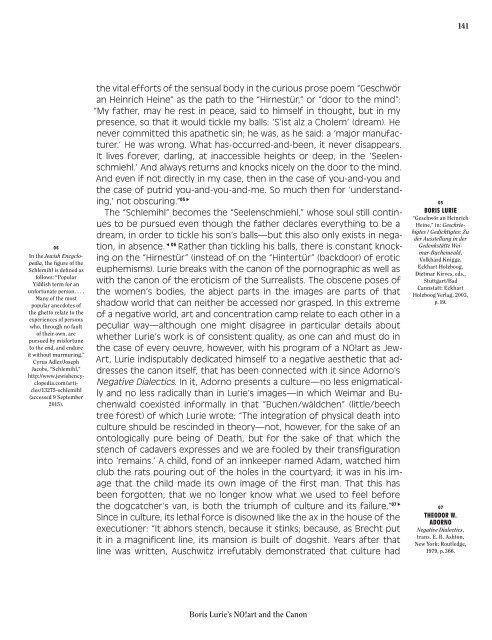The Art of
1WQggTh
1WQggTh
Create successful ePaper yourself
Turn your PDF publications into a flip-book with our unique Google optimized e-Paper software.
141<br />
06<br />
In the Jewish Encyclopedia,<br />
the figure <strong>of</strong> the<br />
Schlemihl is defined as<br />
follows: “Popular<br />
Yiddish term for an<br />
unfortunate person. . . .<br />
Many <strong>of</strong> the most<br />
popular anecdotes <strong>of</strong><br />
the ghetto relate to the<br />
experiences <strong>of</strong> persons<br />
who, through no fault<br />
<strong>of</strong> their own, are<br />
pursued by misfortune<br />
to the end, and endure<br />
it without murmuring.”<br />
Cyrus Adler/Joseph<br />
Jacobs, “Schlemihl,”<br />
http://www.jewishencyclopedia.com/articles/13275-schlemihl<br />
(accessed 9 September<br />
2015).<br />
the vital efforts <strong>of</strong> the sensual body in the curious prose poem “Geschwör<br />
an Heinrich Heine” as the path to the “Hirnestür,” or “door to the mind”:<br />
“My father, may he rest in peace, said to himself in thought, but in my<br />
presence, so that it would tickle my balls: ‘S’ist alz a Cholem’ (dream). He<br />
never committed this apathetic sin; he was, as he said: a ‘major manufacturer.’<br />
He was wrong. What has-occurred-and-been, it never disappears.<br />
It lives forever, darling, at inaccessible heights or deep, in the ‘Seelenschmiehl.’<br />
And always returns and knocks nicely on the door to the mind.<br />
And even if not directly in my case, then in the case <strong>of</strong> you-and-you and<br />
the case <strong>of</strong> putrid you-and-you-and-me. So much then for ‘understanding,’<br />
not obscuring.” 05<br />
<strong>The</strong> “Schlemihl” becomes the “Seelenschmiehl,” whose soul still continues<br />
to be pursued even though the father declares everything to be a<br />
dream, in order to tickle his son’s balls—but this also only exists in negation,<br />
in absence. 06 Rather than tickling his balls, there is constant knocking<br />
on the “Hirnestür” (instead <strong>of</strong> on the “Hintertür” (backdoor) <strong>of</strong> erotic<br />
euphemisms). Lurie breaks with the canon <strong>of</strong> the pornographic as well as<br />
with the canon <strong>of</strong> the eroticism <strong>of</strong> the Surrealists. <strong>The</strong> obscene poses <strong>of</strong><br />
the women’s bodies, the abject parts in the images are parts <strong>of</strong> that<br />
shadow world that can neither be accessed nor grasped. In this extreme<br />
<strong>of</strong> a negative world, art and concentration camp relate to each other in a<br />
peculiar way—although one might disagree in particular details about<br />
whether Lurie’s work is <strong>of</strong> consistent quality, as one can and must do in<br />
the case <strong>of</strong> every oeuvre, however, with his program <strong>of</strong> a NO!art as Jew-<br />
<strong>Art</strong>, Lurie indisputably dedicated himself to a negative aesthetic that addresses<br />
the canon itself, that has been connected with it since Adorno’s<br />
Negative Dialectics. In it, Adorno presents a culture—no less enigmatically<br />
and no less radically than in Lurie’s images—in which Weimar and Buchenwald<br />
coexisted informally in that “Buchen/wäldchen” (little/beech<br />
tree forest) <strong>of</strong> which Lurie wrote: “<strong>The</strong> integration <strong>of</strong> physical death into<br />
culture should be rescinded in theory—not, however, for the sake <strong>of</strong> an<br />
ontologically pure being <strong>of</strong> Death, but for the sake <strong>of</strong> that which the<br />
stench <strong>of</strong> cadavers expresses and we are fooled by their transfiguration<br />
into ‘remains.’ A child, fond <strong>of</strong> an innkeeper named Adam, watched him<br />
club the rats pouring out <strong>of</strong> the holes in the courtyard; it was in his image<br />
that the child made its own image <strong>of</strong> the first man. That this has<br />
been forgotten, that we no longer know what we used to feel before<br />
the dogcatcher’s van, is both the triumph <strong>of</strong> culture and its failure.” 07<br />
Since in culture, its lethal force is disowned like the ax in the house <strong>of</strong> the<br />
executioner: “It abhors stench, because it stinks; because, as Brecht put<br />
it in a magnificent line, its mansion is built <strong>of</strong> dogshit. Years after that<br />
line was written, Auschwitz irrefutably demonstrated that culture had<br />
05<br />
BORIS LURIE<br />
“Geschwör an Heinrich<br />
Heine,” in: Geschriebigtes<br />
/ Gedichtigtes: Zu<br />
der Ausstellung in der<br />
Gedenkstätte Weimar-Buchenwald,<br />
Volkhard Knigge,<br />
Eckhart Holzboog,<br />
Dietmar Kirves, eds.,<br />
Stuttgart/Bad<br />
Cannstatt: Eckhart<br />
Holzboog Verlag, 2003,<br />
p. 19.<br />
07<br />
THEODOR W.<br />
ADORNO<br />
Negative Dialectics,<br />
trans. E. B. Ashton,<br />
New York: Routledge,<br />
1979, p. 366.<br />
Boris Lurie’s NO!art and the Canon


